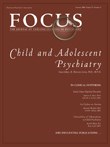An Update on Autism
Abstract
The autism spectrum disorders (ASDs) are relatively common disorders characterized by profound disturbances in social skills. Although the prevalence of ASDs has increased, this increase reflects changes in diagnostic criteria, public awareness, and standards for eligibility for services. The ASDs have a strong genetic basis and are characterized by several neurobiological abnormalities. Various mechanisms have been proposed, but no single factor has emerged as necessary or sufficient to cause ASDs. A thorough diagnostic assessment requires a multidisciplinary evaluation using specialized rating scales and questionnaires. ASDs co-occur with a variety of medical and psychiatric disorders, and the population with these disorders may have difficulty describing what they are experiencing; thus any evaluation should include careful assessment for a range of symptoms. Behavioral and pharmacological interventions are most successful in maximizing adaptive function and ameliorating symptoms but do not treat the core features of the disorders. With better detection and intervention, more children with ASD are becoming self-sufficient adults, and more general psychiatrists are being consulted for a range of different problems. An increasingly important part of caring for children with ASDs is planning for adolescence and adulthood. Inroads are being made in early characterization and diagnosis, and genetic and neurobiological mechanisms are being elucidated. This work is being integrated with the emerging body of social neuroscience research. The autism research field, as a whole, is in a period of great productivity and holds great promise for clarifying etiology and refining intervention in the near future.



